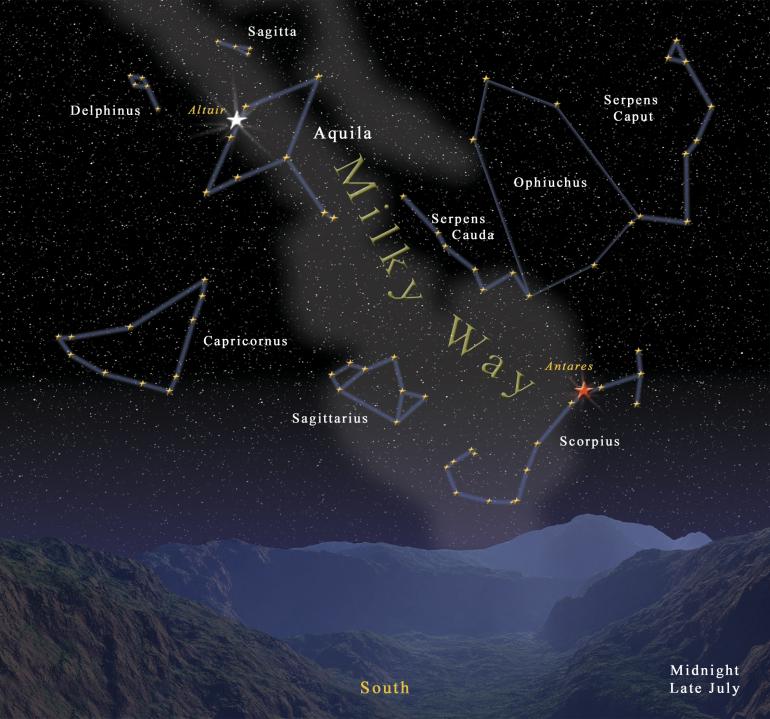The Eagle in the Sky
There’s no time like summertime to celebrate American icons—Mom, apple pie, and the flag mixed with lemonade on the back porch, fireworks on the Fourth, Old Faithful spouting in Yellowstone, and of course, that national symbol: the bald eagle, gazing steely-eyed from some lofty perch.
You can spot the baldies regularly in these parts, outside Bozeman surveying from the tops of telephone poles or flying above the East Gallatin River, swooping for fish at Canyon Ferry reservoir, and nesting along the Madison River in Yellowstone. And if you know where to look, this is also the season when the eagle flies among the stars.
The best way to go eagle-watching in the summer night sky is to look for the Summer Triangle, a large pattern of three bright stars caught in the Milky Way and arching high southward on summer nights. The two northernmost stars of the Triangle are bright Vega and Deneb. The lone southernmost is white Altair, a sun brighter and bigger than our own and a mere 17 light years distant—a neighbor by cosmic standards. Altair is flanked by a pair of dimmer stars, and these three fit neatly into a medium-bright diamond-shape of stars that outline the wings of Aquila the eagle, with Altair marking the bird’s shoulder. Add some tail-feather stars down and right of the diamond, and our nation’s bird is complete.
Eagles have always been a bird of kings, and this was also true for the Greek king of heaven, Zeus. Aquila, legend tells us, was a longtime associate of the king of the gods, and like many subordinates, often carried out his boss’ dirty work. During Zeus’ war on the Titans, the precursor gods of the Greeks, Aquila was caddy, carrying the thunderbolts Zeus used to take pot-shots at his rivals. Later on he became a “hit bird” when he carried out Zeus’ orders and dispatched Ophiuchus, the doctor who caused a stir in Olympus by figuring out how to bring people back from the dead. (He now practices in the sky below Aquila). And the eagle turned kidnapper when Hebe, cupbearer of the gods, twisted a lovely ankle and called in sick from her job serving as sommelier to the immortals. Aquila was sent out to fetch a new one and snatched a lovely youth named Ganymede who served handsomely in Hebe’s stead (and was also later rewarded with a spot in the sky as the constellation Aquarius visible in the autumn).
But arguably Aquila’s most grisly task was to participate in the torture of Prometheus, a second-generation Titan who crossed Zeus by stealing fire from heaven and giving it to humanity. For his punishment, Prometheus was chained to Mount Caucasus where daily, a peckish Aquila would flap down to feast on Prometheus’ liver, which grew back every night. This ghastly punishment continued until one day, strongman Hercules happened by and decided to put an end to it. He shot the eagle through with an arrow, and Aquila was placed in the night sky—the godly equivalent of receiving the gold watch after a career of faithful service. (Hercules, for other reasons, is also constellated not far from Aquila in the summer sky.)
Many other cultures fancied an eagle among Aquila's stars; the Navajo may have placed their thunderbird here, who carried wind and lightning under its wings. And the Japanese turn the shoulder star Altair into a pining cowherd in a legend also dependent upon birds. It seems that the cowherd was in love with a princess weaver represented by the star Vega, but the two were separated by the river of the Milky Way. On one summer’s night each year in early July, however, all of the magpies of the land fly up to make a bridge across the starry river, and for one night the two lovers are reunited. This story serves as the central theme for the popular Japanese summer festival of Tanabata.
Summer is the time for celebrating icons. So this Fourth of July, while you’re watching fireworks with a flag in one hand and a slab of apple pie in the other, be sure to give a salute to Aquila the eagle, faithfully patrolling the starry skies above. Semper fi!












